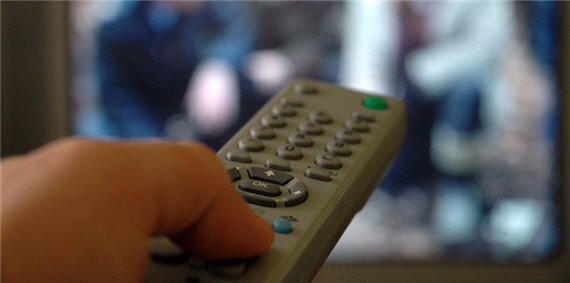DVRs Biggest Power Drain in House?
If someone had given me ten guesses as to the biggest electricity hog in my house, I'd have never guessed it: The set-top box that houses my DirecTV signal and DVR.
If someone had given me ten guesses as to the biggest electricity hog in my house, I’d have never guessed it: The set-top box that houses my DirecTV signal and DVR. Oh: We have three.
NYT (“Atop TV Sets, a Power Drain That Runs Nonstop“):
Those little boxes that usher cable signals and digital recording capacity into televisions have become the single largest electricity drain in many American homes, with some typical home entertainment configurations eating more power than a new refrigerator and even some central air-conditioning systems.
There are 160 million so-called set-top boxes in the United States, one for every two people, and that number is rising. Many homes now have one or more basic cable boxes as well as add-on DVRs, or digital video recorders, which use 40 percent more power than the set-top box.
One high-definition DVR and one high-definition cable box use an average of 446 kilowatt hours a year, about 10 percent more than a 21-cubic-foot energy-efficient refrigerator, a recent study found.
These set-top boxes are energy hogs mostly because their drives, tuners and other components are generally running full tilt, or nearly so, 24 hours a day, even when not in active use. The recent study, by the Natural Resources Defense Council, concluded that the boxes consumed $3 billion in electricity per year in the United States — and that 66 percent of that power is wasted when no one is watching and shows are not being recorded. That is more power than the state of Maryland uses over 12 months.
While surprising, it’s one of those odd quirks of life, right? Our monthly water bill is much lower than, say, our dog walker bill. Things don’t always consume resources in direct relation to their overall value. But, it turns out, it doesn’t have to be that way in this particular case.
“People in the energy efficiency community worry a lot about these boxes, since they will make it more difficult to lower home energy use,” said John Wilson, a former member of the California Energy Commission who is now with the San Francisco-based Energy Foundation. “Companies say it can’t be done or it’s too expensive. But in my experience, neither one is true. It can be done, and it often doesn’t cost much, if anything.”
The perpetually “powered on” state is largely a function of design and programming choices made by electronics companies and cable and Internet providers, which are related to the way cable networks function in the United States. Fixes exist, but they are not currently being mandated or deployed in the United States, critics say.
Similar devices in some European countries, for example, can automatically go into standby mode when not in use, cutting power drawn by half. They can also go into an optional “deep sleep,” which can reduce energy consumption by about 95 percent compared with when the machine is active.
One British company, Pace, sells such boxes to American providers, who do not take advantage of the reduced energy options because of worries that the lowest energy states could disrupt service. Cable companies say customers will not tolerate the time it takes to reboot the system once the system has been shut down or put to sleep.
It depends on what it means for the devices to go into “deep sleep.” Presumably, the reason DVRs need to be “always on” isn’t to save a minute or two each time the customer turns on the television–although, frankly, that wait would in fact be annoying–but because the machine needs to be able to download scheduled programs and accept middle-of-the-night firmware updates.
Naturally, when a cheap solution exists that would redound to the general welfare but for which the market produces no independent demand, government intervention is the natural recourse. It appears that it’s happening, in the form of a nudge rather than a mandate:
Cable companies can become Energy Star “partners” if they agree to install or upgrade boxes so that 25 percent to 50 percent of the homes they serve have “energy star qualified” equipment. The E.P.A. merely encourages providers to use units that can automatically power down at least partly when not in use.
But as of Sept. 1, typical electricity consumption of Energy Star qualified products would drop to 97 kilowatt hours a year from an average of 138; and then by the middle of 2013, they must drop again to 29 kilowatt hours a year. Companies have fought the placement of the “Energy Star” seal on products and the new ambitious requirements, which may still be modified before enacted.
Mr. Wilson recalled that when he was on the California Energy Commission, he asked box makers why the hard drives were on all the time, using so much power. The answer: “Nobody asked us to use less.”
The biggest challenge in reducing energy use is maintaining the rapid response time now expected of home entertainment systems, Mr. Turner said. “People are used to the idea that computers take some time to boot up,” he said, “but they expect the TV to turn on instantly.”
A solution that saves substantial energy but offsets it with noticeable inconvenience will not go over well. One hopes there’s a technological solution to the latter.







“the single largest electricity drain in many American homes”
I’m still thinking lighting, heating and cooling are larger electricity drains. If you say “lighting” isn’t a “single” source, then why is the article aggregating individual multi-media sources. And I’m guessing a “21-cubic-foot energy-efficient refrigerator” isn’t necessarily typical in many homes either. The whole premise looks suspect.
How an article lede that just said home entertainment components are surprising electricity hogs?
This is a pretty idiotic item to get upset over. 446 KWh/yr is less than $50 a year. The bulk of that excess usage is at night when systems aren’t strained. I actually have mine set to go to reduced mode if inactive for 3 hrs. Reduce the usage and they just go up on the power rates to make up the government mandated profit for the utility.
The solution is for these energy efficiency advocates to get a life and stop pestering people who have a life.
@PD: Not sure how they’re doing the calculations.
@JKB: Yes, that’s an important point: If the “single biggest” is still small, it may not much matter. The counterargument is that, multiplied by a hundred million households, it’s a big problem, especially since the grid is strained in many places.
Of course, the goal ought be, not to achieve lower energy use, but more efficient energy use.
And if the most efficient approach is for me not to give a f*ck whether my cable box is on, then I am already green as green can be.
Stated differently, the most peaceful (and zero-carbon-footprint) place on earth is a graveyard.
P.S. How soon before the NRDC comes after broadband modems and wireless routers, which also tend to be on 24/7/365?
Conservatives: Not much use for conservation in anything other than government budgets. My own budget, not so much.
I think there’s something wrong here. A 22 cf CEE Tier 3 refrigerator (there aren’t a lot of these out there) uses about 425 KWh per year. According to the NRDC, the least efficient DVRs use about 400 KWh per year.
Yes, it’s a choice between a DVR running 24/7 and death. There are no other options, only extremes in the minds of extremists.
@Dave Schuler,
I take this as meaning an average for the 2 devices.
@James,
I bet that is the reason. I would assume middle of the night updates could be proceeded by a wake up signal.
I bet that is the reason. I would assume middle of the night updates could be proceeded by a wake up signal.
That’s what mine does. It’s off (or on stand-by or whatever) the vast majority of the time, since I don’t actually watch all that much. Turns on to update at 3am. This whole article confuses me.
There’s no reason for a minute or two boot up from a soft sleep. Just shutting down the hard drive would save power directly and indirectly via reducing heat generation which means the fan can be throttled back.
Currently when my computer goes to sleep you would swear it was turned off but just hitting the power button results in a nearly instant loading desktop (I run XP pro corp still so it takes a couple seconds). I can wake my machine up over my network if I wanted. My machine is over 3 years old now and none of this is remotely new technology nor am I running a SSD hd or anything to speed up the process..
IIRC, I used my Kill-A-Watt, tuned and replaced appliances, and got down to about a $16 electric bill. I added a DVR and got a bop up to about $20. A big percent of the reduced house load, though I’d think the fridge was still the highest single draw for most folk.
BTW my guess would be that DVRs draw because their makers just don’t care. Efficiency is not a design concern.
For anyone at all interested, google “Kill-A-Watt.” It plugs between the wall and the device and counts KWH. I think mine was about $20
(Out of town, can’t throw mine on the DVR.)
BINGO..
I live deep in the heart of Texas so most of my power goes towards A/C which is set at 80 during the day.